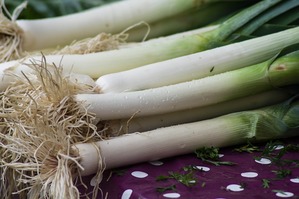Leeks
Leeks are originally from the Mediterranean countries. From here the Romans spread it to Europe. Today it grow most on our latitudes.
Why eat and grow leeks
Leeks is healthy because of their content of important nutrients, vitamins and minerals. Leeks have a high content of dietary fiber, which ensures a long-lasting feeling of satiety and strengthens your digestion.

The leeks also have a high content of potassium, which helps regulate fluid balance and at the same time counteracts accumulated fluid in the body. At least it strengthens the immune system, and can help lower your blood pressure.
Leeks are one of the vegetables that it really pays to grow and it is nice to harvest one or two perfectly healthy leeks most of the year.
If you want fresh leeks all winter, choose varieties that can withstand frost and winter’s changeable weather. I would suggest that you choose:
- An autumn variety that provides a high yield of early, long-handled leeks of fine quality
- A winter variety – they are fairly short-shaven and slightly more coarse, but provide a safe yield of fresh leeks throughout the winter.
Cooking and use
There are thousands of different ways to prepare leeks. You can eat them raw, baked, fried, steamed and boiled. The white part is the mildest in taste, but the green is richest in vitamins and minerals.
Always remember to clean leeks thoroughly.
How to cultivate

Leeks is easy to grow as it can grow in any area and in different soil types. However, it is important that the soil is free of stones and weeds. You can harvest leeks from the end of July
Leeks do not require as much care. However, it is important that you keep the weeds away from the plants, as it steal the nourishment. Initially you can keep the weeds away by turning the soil, later you apply a layer of cut grass or, plant ground cover to keep the weeds away.
Leeks and seed change
Leek is good for blending culture, as it first needs a lot of space at the end of the season. It thrives well between carrots, celery and broccoli.
This allows you to make the most of the space garden and at the same time to prevent a number of diseases.
Pre-cultivation of leeks
You can germinate the leeks and then transplant them. You can also sow them directly on the open field in April, but they do not grow as large as they transplanted.
The best part is that you pre-cultivate the leeks inside or in the greenhouse. It gives them more months to grow. You can start pre-cultivating them as early as January and until April.
You sow the leeks in boxes with a good compost soil at the bottom. Lay a layer of soil over where you sow the seeds. Cover with ½ – 1 cm of soil. The soil should be suitably moist, and give a slight sprinkling after sowing. Leeks should have sufficient space, so thin to 2 cm distance between the plants. You can move the boxes outdoors in May for curing one to two weeks before transplanting.
Planting
Leeks do not hurt to stand in the boxes, so wait until planting until the danger of night frosts is over.
You should dig an approximately 10 cm deep groove into which you plant the leeks. The deep groove will make it easier for you to later hyperlink the leeks. The hip gives the leeks the white piece at the bottom for which they are so well known.

You can plant leeks at different distances. If you want them thick, they must stand at a great distance (50 cm between the rows and 15 cm distance in the row). You get thinner leeks about 10 cm between the plants.
You can choke the weeds by loosening the soil between the rows and gently chopping some of the loosened soil into the grooves. You can also keep the weeds away by covering the soil with co
mpost. This holds on to the moisture and fertilizers. You must continuously fertilize with compost
In November, it is a good idea to put a thick layer of leaves between the leeks so that they will not lack water in freezing weather as it can damage the leeks. It also ensures that you can pick up leeks in freezing weather.
